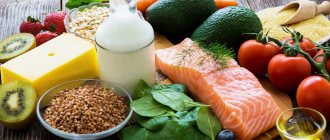What is separate nutrition?
Separate nutrition is a nutrition concept that is based on the compatibility of different foods with each other. According to this theory, incompatible foods should be consumed at different times during the day. Another option for separate meals is to eat separate food groups on different days.
The founders of this approach to nutrition are Herbert Shelton and William Hay. The theory was described by Shelton in his book Proper Food Combination, published in 1928.
According to the author, the body secretes a large number of enzymes to digest foods of various compositions. However, their productive work requires different conditions: protein foods require an acidic environment, and carbohydrates require an alkaline environment. Therefore, when proteins and carbohydrates are consumed together, enzymes begin to neutralize each other, and the process of food absorption slows down. As a result, the degree of absorption of nutrients is significantly reduced.
Separate food: product compatibility table
The table below shows the recommended compatibility and incompatibility of food products in accordance with the circumstances they require during their digestion. Incompatible products can be consumed with a time difference of at least two hours.
| 1 | 2 | 3 | 4 | 5 | 6 | 7 | 8 | 9 | 10 | 11 | 12 | 13 | 14 | 15 | 16 |
| 1. Meat, fish, poultry | — | — | — | — | — | — | — | — | + | 0 | — | — | — | — | — |
| 2. Cereals and legumes | — | 0 | + | + | — | 0 | — | — | + | + | — | — | — | — | 0 |
| 3. Butter, cream | — | 0 | 0 | — | — | + | + | — | + | + | 0 | — | 0 | — | — |
| 4. Sour cream | — | + | 0 | 0 | — | + | + | 0 | + | + | — | + | 0 | 0 | — |
| 5. Vegetable oil | — | + | — | 0 | — | + | + | 0 | + | + | — | — | — | — | + |
| 6. Sugar, confectionery | — | — | — | — | — | — | — | — | + | — | — | — | — | — | — |
| 7. Bread, cereals, potatoes | — | 0 | + | + | + | — | — | — | + | + | — | — | 0 | — | 0 |
| 8. Sour fruits, tomatoes | — | — | + | + | + | — | — | 0 | + | 0 | — | 0 | + | — | + |
| 9. Sweet fruits, dried fruits | — | — | — | 0 | 0 | — | — | 0 | + | 0 | 0 | + | — | — | 0 |
| 10. Green and non-starchy vegetables | + | + | + | + | + | + | + | + | + | + | — | + | + | + | + |
| 11. Starchy vegetables | 0 | + | + | + | + | — | + | 0 | 0 | + | 0 | + | + | 0 | + |
| 12. Milk | — | — | 0 | — | — | — | — | — | 0 | — | 0 | — | — | — | — |
| 13. Cottage cheese, fermented milk products | — | — | — | + | — | — | — | 0 | + | + | + | — | + | — | + |
| 14. Cheese, feta cheese | — | — | 0 | 0 | — | — | 0 | + | — | + | + | — | + | — | 0 |
| 15. Eggs | — | — | — | 0 | — | — | — | — | — | + | 0 | — | — | — | — |
| 16. Nuts | — | 0 | — | — | + | — | 0 | + | 0 | + | + | — | + | 0 | — |
To bring some clarity regarding the above categories, the following should be noted:
- sour fruits are citrus fruits, pineapple, pomegranate, cranberries, sour varieties of apples, pears, plums, apricots, grapes; this also includes any varieties of tomatoes containing citric, malic and oxalic acids;
- semi-acidic fruits are blueberries, strawberries, raspberries, strawberries, sweet varieties of apples, cherries, plums, grapes, apricots, peaches;
- sweet fruits - grapes, persimmons, dates, figs, raisins, dried apricots, prunes, dried pears and sweet apples;
- starchy vegetables - beets, carrots, horseradish, parsley and celery roots, pumpkin, zucchini and squash, cauliflower;
- green and non-starchy vegetables - parsley, dill, celery, radish tops, beets, various types of lettuce, white cabbage, green and onions, garlic, cucumbers, eggplants, bell peppers, green peas, radishes, rutabaga, radishes and turnips .
Basic rules for separate meals
1. One meal should contain foods from only one food group. It is necessary to exclude the following combinations of foods from the diet:
- fish and buckwheat;
- potatoes and meat;
- breaded fish;
- sandwich with cheese and sausage;
- meat and pasta;
- scrambled eggs and cheese;
- rice and chicken.
2. One flour product per day is allowed.
3. Fruits and foods containing sugar should not be mixed with animal proteins.
4. You cannot combine sour fruits with flour products.
5. It is advisable to refuse milk. If this fails, then it is better to drink it separately from other foods or combine it with fruit.
6. Watermelon and melon do not go well with any other foods; they should be eaten separately.
7. Protein products do not go well with cream, sour cream and butter.
8. Dried fruits should be excluded from the diet.
Recommendations for separate meals
In order to get the maximum benefit from separate nutrition, you should follow some rules:
- Drink enough water, but do not drink during meals and do not drink earlier than an hour and a half after eating;
- Reduce your usual portions by half;
- Lead an active lifestyle, play sports, burn off the calories accumulated during the day;
- Consume only natural products;
- Eat slowly to feel full;
- Include more fresh fruits and vegetables in your diet;
- Limit salt intake into the body;
- Take at least a two-hour break between consuming proteins and carbohydrates;
- Don't eat fruit for dessert. It is advisable to consume them separately from other products;
- Eliminate fatty, sweet and fried foods from your diet;
- The last meal should be no later than 3 hours before bedtime.
You need to switch to a new nutrition system gradually to give your body the opportunity to adapt.
Plan your menu in advance
One of the serious mistakes when switching to separate meals is the lack of a pre-planned menu. For someone who does not know what to snack on at the moment, it is much easier to return to familiar dishes than to endure the feeling of hunger. As a result of frequent violations of the nutritional system, the beneficial effect for the body may be zero.
In the first stages of introducing a new regime, it is easy to return to the previous version, since a person does not experience the usual pleasure from eating. In addition to pre-prepared dishes that comply with the principles of the system, doctors recommend including favorite foods on the menu more often in order to compensate for the lack of pleasure from food.
Source: depositphotos.com
Sample menu for the day
Breakfast
It can consist of both protein and separately carbohydrate products. Any fruit or fruit salad, vegetables, cottage cheese, omelet are perfect.
Dinner
This is the main meal. We leave soups and broths for the first place. For the second, you need to use neutral foods (vegetables, herbs) along with protein or carbohydrate dishes.
Protein example: a salad of non-starchy vegetables with baked fish or boiled meat or poultry.
Carbohydrate example: any vegetables in combination with any porridge, pasta, baked potatoes.
Dinner
It should be the opposite of lunch, that is, if you had protein for lunch, then you should eat carbohydrates for dinner, and vice versa. In the evening, it is advisable to eat lighter and less calorie foods.
It is recommended to drink juices between main meals. Non-acidic juices can be combined with bread.
Menu for separate meals for a week
Having chosen separate meals for weight loss, an individual menu is created for the week or a ready-made option is used - the table includes 5 meals with an interval of 3 hours.
Carbohydrates can be taken at any time, but it is recommended to “load” with a macronutrient in the morning or before training to provide the body with the energy it needs.
| Day of the week | Breakfast | Lunch | Dinner | Afternoon snack | Dinner |
| Monday | Omelet + broccoli + tea without sugar | Green apple | Lenten soup with potatoes and carrots | Skim cheese | Boiled fish + asparagus/green beans |
| Tuesday | Steamed buckwheat + cucumber and Chinese cabbage salad + tea without sugar | Low-fat cottage cheese + natural yogurt without additives | Lenten vegetable soup | A piece of hard cheese | Braised chicken liver + green salad |
| Wednesday | Oatmeal with water + coffee without sugar | Crispbread + slice of cheese | Vegetable stew of green beans, onions, carrots stewed in its own juice | Melon | Steamed salmon + cucumber salad |
| Thursday | Oatmeal in water with dried apricots + tea without sugar | Green apple | Spinach puree soup + boiled chicken fillet | Banana + herbal tea without sugar | Boiled veal + seaweed |
| Friday | Omelet + spinach + tea without sugar | Grapefruit | Steamed broccoli + steamed turkey fillet | Low-fat cottage cheese + dried apricots | Baked pumpkin with prunes |
| Saturday | Multigrain porridge with water + tea with herbs | A portion of nuts (to taste) | Pumpkin puree soup with water | Watermelon | Boiled green peas + steamed turkey fillet |
| Sunday | It is recommended to spend a fasting day on your favorite product (for example, 1% kefir, oatmeal, apples or buckwheat) | ||||
Pros of separate power supply
Separate meals are often used as a diet for losing excess weight. The advantage of this technique is that compatible products quickly pass through the digestive tract. Separate meals virtually eliminate overeating. The load on the pancreas is reduced. Weight loss occurs gradually, and overall health improves. The menu is enriched with a large variety of products. This is a good basis for leading a healthy lifestyle.
Of course, first of all, separate nutrition is effective when cutting, because it helps get rid of excess fat. Athletes who eat according to this system achieve results faster during the drying process than those who practice mixed nutrition.
How to get out of a diet correctly
For the health of the body, any eating plan (especially if it lasted 90 days) needs to be properly completed. This will not only reduce the load on the stomach, which is unaccustomed to the usual menu, but will also ensure that the results are maintained for a long time.
The main advantage of separate nutrition is the acceleration of metabolism. It is important not to slow down its work too abruptly.
4 rules for exiting the separate nutrition course:
- Don't reduce the amount of physical activity.
- Drink enough water - at least 2 liters.
- You can mix foods, but continue to follow a fractional diet and small portion sizes.
- You can follow a diet after completing the course, but not so strictly. For example, do not alternate days with different foods, and do not eat incompatible foods in one meal.
Sample menu:
Breakfast: buckwheat with vegetables, green tea.
First snack: milk or kefir.
Lunch: pea soup, stewed vegetables.
Second snack: fruit salad.
Dinner: baked chicken breast.
Criticism
The effect of a diet based on separate nutrition has been studied in randomized clinical trials. Overweight subjects were divided into two groups. For six weeks, participants in one group followed the rules of separate meals, while members of the other ate a regular balanced diet. The diets contained the same products. After six weeks, participants in both groups showed almost identical weight loss results. Even the concentrations of glucose, cholesterol and insulin in the blood were identical. Measurements of waist and hip volumes in participants of both groups also showed approximately the same result. Scientists have suggested that when losing excess weight, additional division of products into categories is not particularly important. Subjects in both groups lost excess weight only by reducing their caloric intake.1
Start with one fasting day a week
A gradual transition to separate nutrition, according to doctors, is preferable to an abrupt one - both from a physiological and psychological point of view. As a result of a slow change of regime, the body, accustomed to mixed food, adapts to the system without side effects (such as lethargy, loss of strength, bowel movements).
A sudden transition is a serious damage to the psyche, the degree of which depends on the degree of the person’s habit of the previous food. The adaptation period is characterized by acute nutritional dissatisfaction, associated with a constant feeling of hunger. According to doctors, you shouldn’t test your willpower: it’s better to start with one fasting day a week, learning not to mix meat with potatoes, pasta and bread.
Source: depositphotos.com











